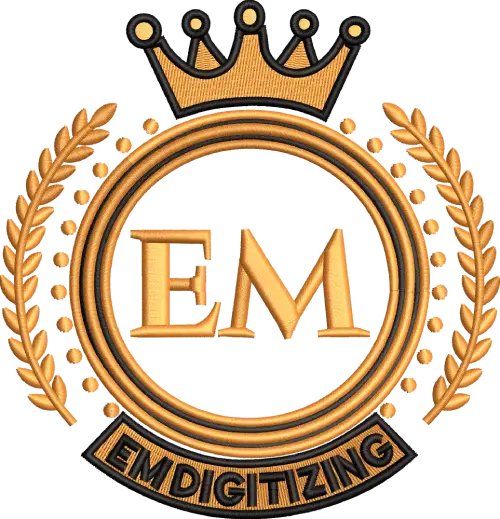Aiguilles de broderie de machines Peut sembler être une petite partie de votre configuration, Mais ils ont un grand impact sur la façon dont votre conception se révèle. Si vous avez déjà eu des fils de rupture, points de suture sautant, ou votre design qui semble désordonné, Il y a de fortes chances que le problème ne soit pas votre tissu ou votre fil, C'était l'aiguille.

J'ai vu de nombreux débutants blâmer leur machine ou leur fichier numérisé lorsque les choses tournent mal, Mais le vrai problème était tout simplement le mauvais choix d'aiguille. C'est pourquoi il est si important de comprendre quelle aiguille à utiliser pour quel tissu, fil, et conception.
Dans ce guide, Nous allons parcourir tout ce que vous devez savoir d'une manière étape par étape, Tout comme nous sommes assis à côté de votre machine, vous aider à le faire dès le début.
Comment choisir les bonnes aiguilles de broderie machine?
Première, Comprendre les parties d'une aiguille

Avant de choisir une aiguille, it’s helpful to know what it’;s fait de. Voici les pièces que vous devez connaître:
- Jarret - c'est la partie supérieure qui s'intègre dans votre machine. Il a généralement un côté plat.
- Arbre - la longue partie de l'aiguille. Son épaisseur vous indique la taille de l'aiguille (comme 75/11).
- Œil - le trou où le fil passe à travers. Les aiguilles de broderie ont un plus grand, œil plus lisse.
- Indiquer (Conseil) - c'est la fin de l'aiguille qui va dans le tissu. Il peut être net ou arrondi.
Rainure et écharpe - Ceux-ci aident à protéger le fil lorsqu'il se déplace et permette à la machine de former des points appropriés.
5 Principaux types d'aiguilles de broderie de machines
Différents types d'aiguille sont faits pour différents tissus et les types de fils. Choisir le mauvais peut provoquer du déchiquetage des fils, points sautés, ou endommager votre tissu.
Passons en revue les principaux types et expliquons quand utiliser chacun.
1. Aiguilles à broder
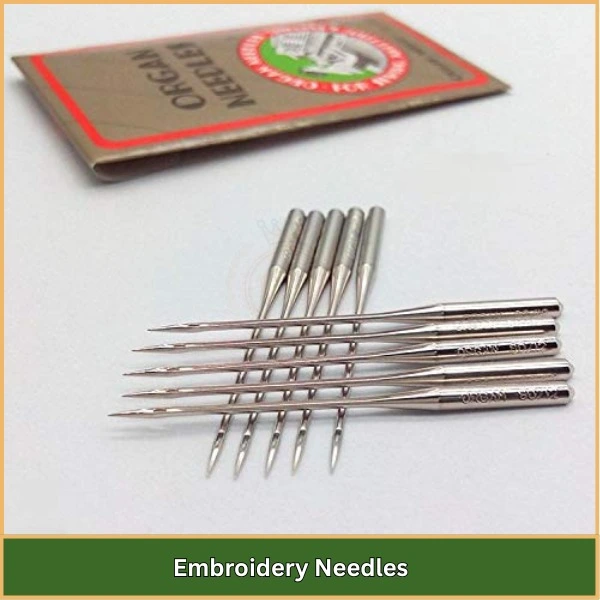
Ceux-ci sont spécialement conçus pour broderie à la machine. Ils ont un plus grand, œil plus lisse ce qui aide à prévenir la rupture du fil, surtout lorsque vous utilisez la rayonne ou le fil métallique.
- Conçu pour la rayonne, polyester, et les fils de spécialité
- Aider à réduire les frictions et le déchiquetage des fils
- Disponible dans différents styles de pointe: pointu ou à bille
Aiguilles à broder sont un incontournable si vous voulez des résultats d'apparence professionnelle.
2. Aiguilles universelles
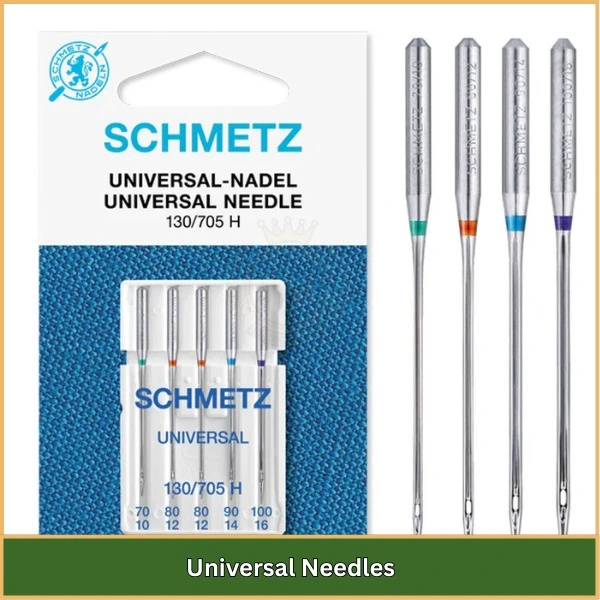
Les aiguilles universelles sont conçues pour la couture générale et sont couramment incluses avec les machines. Ils ont un point standard, pas trop net ou trop rond.
- Bon pour les projets de base et la pratique
- Pas idéal pour la broderie délicate
- Peut provoquer des pauses de fil avec des fils de spécialité
If you’;réalise un travail de broderie sérieux, Ce ne sont généralement pas le meilleur choix.
3. Aiguilles à bille

Les aiguilles à bille ont une pointe arrondie. Ils sont faits pour tissus extensibles ou tricus comme des t-shirts ou du matériel en jersey.
- La pointe ronde glisse entre les fils au lieu de les percer
- Empêche les trous et tire des tissus extensibles
- Idéal pour la broderie sur Soft, matériaux extensibles
Ce sont géniaux si vous voulez éviter tissu dommageable tout en obtenant une broderie propre.
4. Aiguilles de spécialité
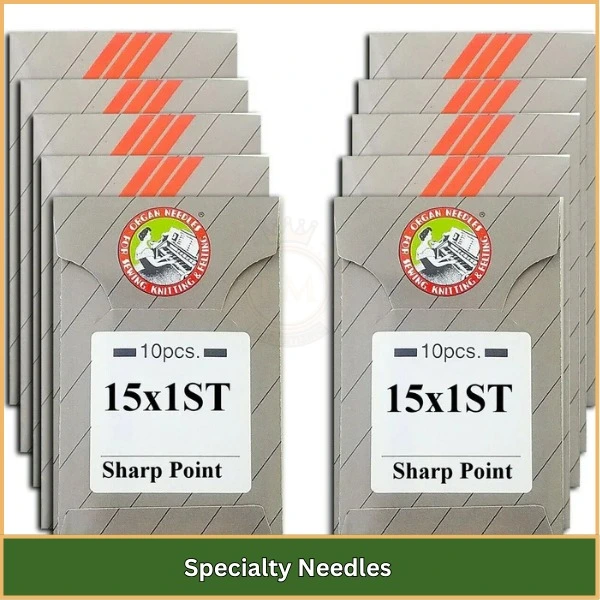
Ceux-ci sont fabriqués pour des utilisations spécifiques, et inclure:
- Aiguilles métalliques - Oeil plus long pour un flux lisse de fils métalliques
- Aiguilles jumelles - Deux aiguilles attachées à une tige, Utilisé pour les doubles coutures décoratives
- Aiguilles étirées - Courbe légère et finition lisse pour les tissus élastiques
- Aiguilles en cuir - Astuce triangulaire faite pour percer des matériaux épais comme le cuir
- Aiguilles de courtepointe - Conçu pour passer par plusieurs couches de tissu et frappeur
Chacun a un travail. Si votre projet a des besoins spéciaux, Choisir l'un d'eux peut faire une grande différence.
5. Aiguilles de broderie en titane
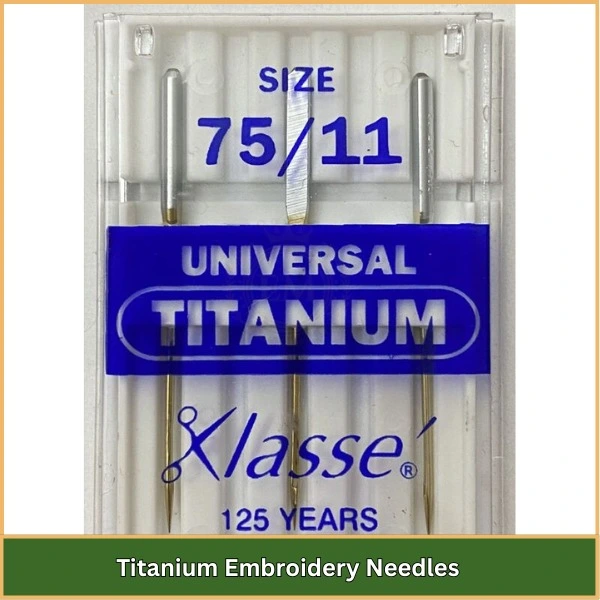
Les aiguilles enrobées de titane sont plus fortes et durent beaucoup plus longtemps que les aiguilles de broderie régulières. Ce sont idéaux pour:
- Machines à broder à grande vitesse
- Tissus épais ou en couches
- Sessions longues de broderie
À cause du revêtement, Ils réduisent la chaleur et portent, Garder vos points lisses et réduire les pauses.
Si vous avez eu des problèmes avec les aiguilles qui se penchent ou terminaient rapidement, essayer d'utiliser aiguilles de broderie en titane.
Choses à considérer avant de choisir une aiguille de broderie
Choisir la bonne aiguille est plus que de choisir n'importe quelle taille dans la boîte. Si vous voulez des points propres, flux de fil fluide, et broderie d'apparence professionnelle, Vous devez d'abord penser à quelques choses importantes. Passons-les un par un.
1. Quel tissu utilisez-vous?
Le type de tissu décide à quel point votre aiguille doit être épaisse ou tranchante.
- Si vous travaillez avec tissu léger comme la soie, organza, ou tulle, utiliser un aiguille plus petite et plus nette (comme la taille 65/9 ou 70/10). Ces tissus sont délicats et peuvent être endommagés facilement.
- If you’;j'utilise tissu extensible comme Jersey ou Spandex, Choisissez un aiguille à bille. La pointe arrondie glisse entre les fils sans les couper, qui empêche les trous.
- Pour tissus moyens comme des mélanges de coton ou de polyester, un Taille 75/11 ou 80/12 aiguille à broder est parfait pour les conceptions générales.
Si vous cousez tissu lourd comme le denim, toile, ou serviettes, opter pour un aiguille plus forte et plus épaisse (comme la taille 90/14 ou 100/16) Ainsi, il peut percer le matériau sans se pencher.
2. Quel fil utilisez-vous?
Tous les fils ne sont pas les mêmes, Et l'œil de l'aiguille doit correspondre à votre fil.
- Fil de broderie standard Comme la rayonne ou le polyester fonctionnent bien avec des aiguilles de broderie régulières.
- Fils plus épais Comme 30 poids ou les fils de spécialité ont besoin d'un œil plus grand Alors ils ne sont pas coincés ou ne se cassent pas. Une aiguille plus grande comme 90/14 fonctionne mieux ici.
Fils métalliques sont délicats et peuvent déchiqueter facilement. Utilisation aiguilles métalliques ou en titane qui ont un extra-long, Oeil lisse pour aider le fil à se déplacer librement.
3. À quel point votre conception est-elle dense?
Le nombre de points dans votre conception affecte également le choix de l'aiguille.
Si votre conception est léger et ouvert, Une aiguille de broderie régulière (75/11 ou 80/12) fera très bien.
Si votre conception est dense avec beaucoup de détails, Choisissez une aiguille plus forte comme aiguilles de broderie en titane. Ils résistent mieux pendant les coutures longues ou complexes.
4. Quel stabilisateur utilisez-vous?
Votre stabilisateur ajoute une épaisseur supplémentaire, Et votre aiguille devrait correspondre au poids total du tissu + stabilisateur.
- Pour stabilisateurs de lumière, surtout ceux solubles dans l'eau, utiliser un petite aiguille Pour éviter de déchirer.
Pour stabilisateurs lourds comme la déchirure coupée ou multicouche, Choisissez un aiguille plus épaisse qui peut gérer la masse sans se casser.
5. Votre machine est-elle compatible?
Vérifiez toujours le manuel de votre machine à broder. Certaines machines domestiques fonctionnent bien avec des aiguilles de broderie standard, Mais d'autres, particulièrement commercial, peut nécessiter des systèmes d'aiguille spécifiques (comme dbxk5 ou hax130ebbr). L'utilisation de la mauvaise aiguille peut endommager la machine ou affecter votre couture.
Quelle taille à l'aiguille de broderie devriez-vous utiliser?
Avant de commencer tout projet de broderie, it’;s important pour choisir la bonne taille d'aiguille. L'aiguille que vous choisissez doit correspondre à votre type de tissu, L'épaisseur de votre fil, Et la complexité de votre conception. L'utilisation de la mauvaise taille peut entraîner des pauses de fil, points sautés, ou endommager le tissu.
Utilisez le graphique ci-dessous comme guide rapide pour sélectionner la meilleure aiguille pour votre projet:
Taille de l'aiguille | Idéal pour | Type de tissu | Fil recommandé |
65/9 | Détails fins, minuscule lettrage | Mousseline de soie, organza, tulle | 60 WT ou plus fin |
70/10 | Conceptions légères | Coton léger, coton de courtepointe | 60–40 WT |
75/11 | Broderie générale | Coton, lin, mélanges de polyester | 40 poids |
80/12 | Designs denses | Sergé, feutre, denim léger | 40–30 WT |
90/14 | Tissus lourds ou fil épais | Serviettes, casquettes, jeans | 30 WT ou métallique |
100/16 | Utilisation lourde | Cuir, toile épaisse, stabilisateurs multiples | 20–30 WT |
Cette tableau de taille d'aiguille de broderie vous aidera à vous faire doucement, propre, et les résultats d'apparence professionnelle en faisant correspondre vos outils avec vos matériaux. En cas de doute, commencer par 75/11, Il fonctionne pour la plupart des projets de broderie standard.
Conclusion - La bonne aiguille donne les meilleurs résultats
Maintenant, vous savez à quel point il est important de choisir le bon aiguilles de broderie de machines. Même si l'aiguille est petite, Il joue un grand rôle dans la façon dont votre fil, en tissu, et concevoir un travail ensemble. Lorsque vous choisissez la bonne aiguille pour votre projet, Vous verrez moins de problèmes, Plus de fils cassés, points sautés, ou designs désordonnés. Votre broderie sera plus fluide et plus professionnelle.
Mais voici quelque chose que beaucoup de gens oublient: Votre conception doit également être numérisée dans le bon sens. Si la numérisation ne correspond pas à votre tissu, fil, et aiguille, Même la meilleure aiguille n'aidera pas. C'est pourquoi la numérisation professionnelle est tout aussi importante que le choix de l'aiguille.
C'est là que EMnumérisation peut vraiment aider. Ce sont des experts dans numérisation de broderie et savoir comment préparer votre conception en fonction du tissu exact, fil, et aiguille que vous utilisez. Vous n'aurez plus à vous soucier des suppositions. Ils s'assurent que votre conception est propre et parfaite, dès le premier essai.
Et la meilleure partie? Tu peux recevoir 50% hors de votre première commande, afin que vous puissiez tester leur qualité sans risque. Leur équipe est également disponible 24/7 Si vous avez des questions ou avez besoin d'aide.
Si vous êtes prêt à améliorer votre broderie et à gagner du temps, essayer EMnumérisation aujourd'hui. Vous verrez la différence de numérisation professionnelle!
FAQ
La meilleure taille d'aiguille pour la plupart des machines à broder est 75/11. Cela fonctionne bien avec régulier 40 Fil de broderie de poids et tissus communs comme le coton, lin, et les mélanges en poly. Cette taille donne des résultats lisses et est parfait pour la plupart des modèles.
Pour choisir une aiguille pour la broderie, Vérifiez d'abord votre type de tissu, lourd, ou extensible. Alors, Faites correspondre les détails de votre épaisseur de fil et de votre conception. Un tissu léger avec du fil mince a besoin d'une petite aiguille, tandis qu'un tissu lourd ou un fil épais a besoin d'un plus grand, plus fort.
Une taille 9 L'aiguille est plus fine que la taille 14. Dans les tailles d'aiguille, Plus le nombre est petit, Plus l'aiguille plus mince. Taille 9 est bon pour le doux, Tissus légers et fils minces, tandis que la taille 14 est pour un tissu épais ou des fils plus lourds.
Vous pouvez choisir la bonne aiguille de broderie en regardant votre tissu, fil, et conception. Pour les tissus doux ou délicats, Utilisez une aiguille plus petite. Pour les tissus extensibles, Utilisez une aiguille à bille. Pour des conceptions de tissu lourd ou dense, aller avec un plus fort, aiguille plus épaisse.
